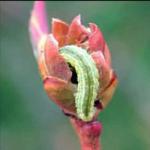We sent out a Winter Moth fact sheet in the April 8, 2015 newsletter. Look for it! These photos are included in the fact sheet:
It's not too soon to be thinking about winter moth. We are a bit lucky in that we can usually find WM in blueberry ahead of when they will be in cranberry. However, you can track potential egg hatch yourself. Eggs hatch when temperatures average around 55°F. It is believed that egg hatch in Massachusetts occurs when approximately 177-239 growing degree days (GDD) above a base of 40°F (starting Jan 1) have accumulated.
GDD can be variable. As of April 8, East Wareham (02538), Norton (02766), and Sandwich (02563) have 42 GDD, East Freetown (02717) has 40, Carver (02330) has 27, and South Dennis (02660) has 37. This is much lower than this time last year (range was 89 to 138 GDD). Visit http://newa.cornell.edu/ orhttp://www.weather.com/outdoors/agriculture/... calculate the Growing Degree Days for your location.
Management: Insecticide sprays timed to coincide with egg hatch are the most effective way of controlling this pest. The timing is important because if the newly hatched caterpillars are allowed to crawl inside the expanding buds, they are protected from any insecticide that might be applied. Scouting should be started early (ca. May 1) to catch these populations. Populations may re-occur as larvae can balloon in. Avaunt, Delegate, and Intrepid are the best choices for control of WM on cranberry. If you have a history of WM, you may need to apply a prophylactic spray early in the season. The Action Threshold for WM is 18 average per sweep set.
Organic growers can use Entrust (spinosad), or one of the Neem products such as AzaDirect, Neemix, or Ecozin in place of the insecticides listed in the table above. Products that contain B.t., may also be effective but depend on the caterpillars ingesting enough product to be effective.
For detailed information concerning the biology and management of Winter Moth, visit the following:
http://extension.umass.edu/landscape/fact-sheets/winter-moth-identificat...
http://extension.umass.edu/landscape/fact-sheets/winter-moth-overview
For current regional updates on the Landscape message:


